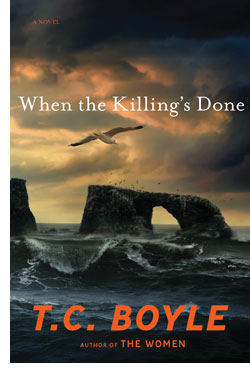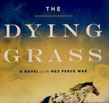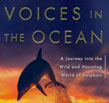 |
 |
 T. C. Boyle
T. C. Boyle
When the Killing's Done
Reviewed by: Rick Kleffel © 2011
Viking / Penguin Putnam
USA First Edition Hardcover
ISBN 978-0-670-02232-8
Publication Date: 02-22-2011
384 pages, $26.95
Date Reviewed: 03-13-2011
Index:
General Fiction
We have National Parks, National Forests, and National Marine Sanctuaries — the wild defined and enclosed. Within those designated spaces is nature, red in tooth and claw. The untamed wild is set aside and preserved in an outdoor version of the jam jars with holes punched in the lids we used as kids to hold our insects captive. The creatures in those jars were indeed wild, even after we set them on our nightstands, usually condemning them to death. But if we set aside a portion of the land and call it nature, what do we become when we enter that domain? Are we human on one side of the line and something else on the other?
Blurring lines is one of T. C. Boyle's many literary strengths, and he draws up overlapping maps of human perception in 'When the Killing's Done' (Viking / Penguin Putnam ; February 12, 2011 ; $26.95). Boyle's latest novel pits two natural — in all senses of the word — allies against one another in a complex contemplation of where exactly nature ends and man begins. It's a ripping yarn that encompasses the rage of nature and the frailty of human morals, then lets the reader wonder whether or not there is a difference.
Boyle begins with a telling epigraph from the Bible, wherein Gods hands over ownership of the animals to humanity. The problem is, of course, that we are animals, even Alma Boyd Takasue, the National Park Service biologist in charge of exterminating invasive species on California's Channel Islands, and Dave LaJoy, an animal rights activist who opposes killing of any animal. Boyle balances these potential allies nicely. Alma is quiet and reserved, but dedicated to the preservation of the species unique to this environment. Of course, she'd prefer not to kill anything. But looking at the potential extinction of species unique to the Channel Islands, it is clear to her that she has no choice. She has made the right decision for nature and for herself. Boyle immerses readers in the perceptions of a character who sees everything around her in terms of a balanced or unbalanced ecosystem, even traffic jams. She's a joy to read.
Dave LaJoy, on the other hand, is a cranky self-made minor millionaire who has a moment of insight that turns his inner selfishness into a single-minded mission to "save the animals," no matter how repulsive or destructive they may be. He's certainly not a guy you want to eat dinner with, as the chances are great that he will send back his meal if it doesn't suit his tastes. Not much suits LaJoy except his girlfriend, Anise Reed, and the elaborate pranks he pulls to carry on his quest. LaJoy's character inspires Boyle's prose to sublime comedic highs.
'When The Killing's Done' fires off with a powerfully written shipwreck off the island of Anacapa, a historical tale that leads us into the present. Throughout the novel, we read of shipwrecks and awful island conditions, and it's Boyle's descriptive prose that puts us in these rough, natural landscapes. Boyle's so good you won't think until well after you've finished the book about how the very-human Boyle managed to evoke the ravaging awe of nature with nothing but words. What could be more artificial than words, a uniquely human creation? And that is indeed the question that Boyle spotlights from all angles, casting shadows in every direction. The dead-certain moralities of the characters serve only to highlight the readers' more ambiguous overview. This book is a pleasure to read on a variety of levels.
As a novel, 'When the Killing's Done' is both fast-paced and cleverly constructed. The set pieces offer comedies that escalate into tragedy, and grand human suffering that is dwarfed by the machinations of the Rube-Goldberg results when man tries to manipulate nature. Every line is drawn with crystal clarity and then blurred by the farcical nature of that busiest of animals, Homo sapiens. Perhaps "sapiens" is overstating the matter. We like to think we can think. But we're just walking chemical factories like every other living thing on this earth. The problem is that we're able to build chemical factories. It's natural for us to do so. But are the factories themselves natural? 'When the Killing's Done' is a page-turner that will alter your perceptions of your own place in nature, and make it entertainingly difficult to decide where you end and nature begins.
|
 |
|
|
 |
| |
Review Archive
All Reviews alphabetized by author.
General Fiction
Non-Genre, general fiction and literature.
Horror
Supernatural fiction, supernatural horror and non-supernatural horror.
Science Fiction
Science fiction, science fantasy, speculative fiction, alternate history.
Fantasy
Fantasy, surrealism and magic realism.
Mystery
Crime, thrillers, mystery, suspense.
Non-Fiction
Non-Fiction, True Crime, Forteana, Reference.
Poetry
|
|
 |
|




